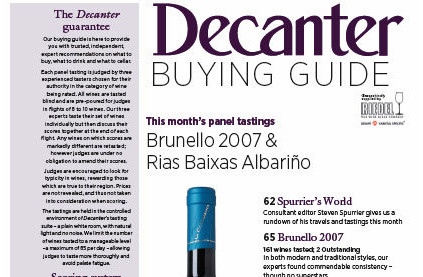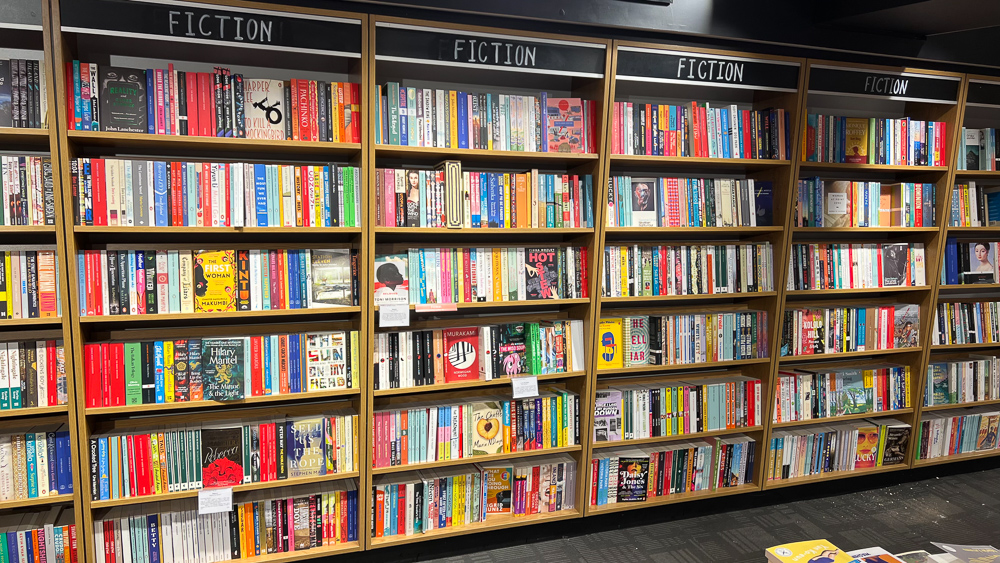In a progressive move, UK-based wine magazine Decanter has announced that it adopting the 100 point scale for its tasting section, and that it is reducing the number of tasters for each session to three. Significantly the individual scores of each taster will now be published.
By doing this, Decanter are presumably hoping to reduce the noise that comes from having a larger panel of tasters and then just averaging their scores. The Decanter magazine has been improving over the last few years, but the weakest bit has always the tasting section, which often (in my opinion, whatever that is worth) turns out perplexing results.
Moving to the 100 point scale from the 20 point system is also a positive move, because this has become the benchmark scale for assessing wines. [However, editor Guy Woodward informs me that tasters will still be scoring on a 20 point scale, because that is what most are used to, and Decanter will then convert this to 100 points and list it alongside the 20 point score.] We’re all familiar with the shortcomings of points, but they are a remarkably useful tool, albeit a limited one, for separating the best wines from the rest. If you give me a tasting note, that has some use, but it doesn’t really tell me how much you liked the wine.
If you tell me one Pinot Noir gets 87 points, and another gets 91 points, I can see that you liked the latter quite a bit more. This is useful information for me.
Publishing individual taster’s scores is also a good move. The score is not a property of the wine, but of the interaction between the wine and the taster. Individual scores will make each taster more accountable, and they will likely perform better. The are also useful for readers: if they can see that one person likes big, oaky, international-styled red wines, and scores by size and ripeness, then they can choose to follow or ignore this taster’s scores.
It will expose the bad tasters ruthlessly, too! Some people, even experienced tasters, just aren’t good at judging blind. I’m looking forward to seeing this new system in action.
Here’s Decanter’s conversion chart, showing how a 20 point score becomes a 100 point one – new-decanter-panel-tasting-system
12 Comments on Decanter switches to 100 point scale and will publish individual taster’s scores



I agree, and of course what it also means is that where there are room splitting wines (which lets face it, some of the most interesting wines often split rooms) readers can see that a wine has scored high and low, not just 16/20.
I’m far more likely to buy a wine if one person scores it 19/20 and another 14/20 (if I find I like wines by the first taster) than I am one that scores 16.5 overall. (or the 100 point equivalent which I’m not clever enough to calculate)
Hopefully what it’ll mean is that more wines will get more airing rather than just the handful of wines that are crowd pleasers but may have been made to do just that.
This is absolutely great news.
Ever since I found out that e.g. there are ways for tasters to stand out… http://www.adegga.com/user/ is a possibility…
…it is always great to follow the advice of someone that has a similar taste…
When it comes to competitions and tastings I have always been asking for individual tasting notes…
Especially if you make wines that are awfully locked up (yes screwcap) and as Tim writes “splits rooms” you need a different approach.
A further aspect comes in mind, when you look at a wine symposium.
Locally, we have a Pinot Gris Symposium and most of the participants like to win that Pinot Gris Prize…
… and then the Ahr Valley had their Pinot Noir Symposium also accompanied by a competition…
… and the winner was a wine that pleased most of the tasting panel… but doesn’t show the diversity in styles that makes a symposium worthwhile.
Decanter’s step towards individual taster’s score is the way to go and I do hope that others will follow very soon…
Best regards
Patrick
‘If you tell me one Pinot Noir gets 87 points, and another gets 91 points, I can see that you liked the latter quite a bit more.’
Actually the difference is only 4/100 points so ‘slightly more’ would be more accurate. The problem is that tasters never mark below 80, or even 85 so differences are magnified.
So, if no taster ever scores under 80, you have to get 180 points to get a 100 points wine?
Interesting and hopefully this will mean an improvement.
If you tell me one Pinot Noir gets 87 points, and another gets 91 points, I can see that you liked the latter quite a bit more.
So if you taste a wine that is perfectly made, a beautiful example of the variety that ticks all the boxes and will thrill devotees of it – but you personally don’t like that variety you mark it down?
I thought the idea on panels like IWC and Decanter was to judge the wine impartially.
This is a nice development for the magazine; changing to three tasters, reporting their notes individually, in focused tastings, should work well. After all, it works well for the World of Fine Wine.
I find some of your comments flawed though. To describe any system as “benchmark” while admitting in the same post that, correctly in my opinion, points have numerous shortcomings and limitations, seems contradictory. Any point system is a method of communicating preferences, not the inherent quality of a wine (unless you also believe in the ‘universal palate’), and the 100 system is no better/worse than any other in its flaws. Hardly a benchmark.
If by “benchmark” you meant it is the predominant system, that is a rather insular and Anglophone viewpoint. Influential American publications use 100 points and some others have fallen in behind. But there are also influential names and publications sticking to the 20-point system, including Decanter it seems (although whether this is in fact step one of a phased change remains to be seen), Jancis Robinson, The World of Fine Wine, La Revue des Vins de France, Gault Millau, Le Rouge et Le Blanc and no doubt one or two others.
Thank you for raising this. It’s reminded me to cancel my subscription. The answers to the recent poll were the final straw.
It is a non event for me. Even though I subscribe,it is tabloid wine mag compared to the broadsheet WOFW.
Not sure about the use of the ‘+’ symbol. So 18.75 corresponds to 95+ ? Why not 95.5 ? I would much prefer 95+ to mean the wine scores 95 today but will get better.
Jamie, this left me really puzzled:
By doing this, Decanter are presumably hoping to reduce the noise that comes from having a larger panel of tasters and then just averaging their scores.
So you’re basically assuming more noise in an average than in an individual score? This is the complete opposite of what my stats lessons taught me. The larger the panel, the lower the variance.
I can understand that Decanter wants to lower the number of tasters to reduce costs, to pretend this is going to be more informative to the customer is just plain n’importe quoi, and I’m feeling sorry you’re reporting whatever their com plan is.
Jamie,
whilst I agree to some extent with your comment RE: “If you tell me one Pinot Noir gets 87 points, and another gets 91 points…” and hence the validity of a points system, I completely fail to see how a points system that neglects over half of the numbers in it ( i.e. anything less than 66 by the looks of it for the 100 point system )can be meaningful.
Far better is it not to be more precise with the points e.g a 20 point system that allocates a max, to the three areas of sensory analysis – appearance, aroma and palate, the break down of which can be far more useful than the vagueness of 91 points Vs. 90 points. How can a faulty or inferior wine rack up 66 points?
Also, RE: your comment “If you give me a tasting note, that has some use, but it doesn’t really tell me how much you liked the wine” – from the tasting notes you write Jamie I get a real sense of how you liked ( or not ) the wine, so to me the tasting note has more use than you seem to give it credit for.
Thankfully both scales will be published and I’ll be very interested in the individual taster scores and notes.